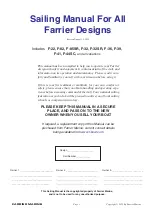
FARRIER MARINE
Page 13
Copyright © 2012 By Farrier Marine
SAILING
This manual is not intended to be a Sailing
Instruction Manual, and it is presumed that all owners
will have a basic sailing knowledge and skill. There are
however, many aspects of sailing a Farrier trimaran
efficiently, and the following covers some of these:
THE BASICS
The mainsail is usually hoisted first. Turn directly into
the wind and commence pulling on the halyard. You may
find winching necessary to get the main fully up, and if
fitted, use the jib halyard winch. If the boom roller furling
system is fitted, the main will automatically unroll from the
boom. Winch the halyard tight until all the wrinkles just
disappear from the mainsail luff, no tighter, and lock the
halyard with the rope clutch. The topping lift can now be
eased.
All models sail and tack easily under mainsail alone,
unless a non-standard mainsail with an oversize square-
top/roach has been fitted. These can be impossible to
tack main only, plus be dangerous downwind.
If you have a lot of tacking to clear a channel then it
may be much easier with just the main. You don’t have to
worry about tacking the jib, you won’t be going too fast,
particularly in crowded waters, and visibility is excellent.
The correct technique for sailing mainsail only is to
sheet it free to avoid choking the boat. The traveller can
be locked on the centerline, and the mainsheet slack-
ened off so the boom is about 12" out from center. Your
boat speed should be 5 - 6 knots in 10 to 15 knots of wind,
even better with a rotating mast. If less, then the problem
is an oversheeted main or trying to point too high.
There is a technique involved in sailing main only, and
3/4" with Rotating masts (even less with wing masts), to
3 to 5" with fixed masts. Mainsail should then be cut to
suit this.
There is no correct amount of prebend as such, other
than each mast should have some, as it will help stabilize
the mast, and it can also be used to control the mainsail
shape to some degree. This means that if the mainsail is
cut for say 3" prebend, less will make the main fuller for
light airs. More will tend to flatten the main for windy
conditions.
Prebend in Rotating masts is harder to adjust in this
regard, but the ability to rotate the mast can give an even
greater control over mainsail fullness.
For good windward performance the forestay
MUST
BE TIGHT
and this is essential. Fixed masts can increase
forestay tension by pulling on the shroud tensioners,
along with more mainsheet tension. Rotating masts can
only use mainsheet tension, but the superior mainsail
shape due to the rotating mast, more than makes up for
any jib luff sag
An important rule, vital to the well being of all masts,
particularly fixed masts, is to be sure that your leeward
cap shroud never becomes
TOO LOOSE.
Some loose-
ness is not unusual, but if it is very loose and visibly
flopping around, you could risk losing your mast.
To tighten the shrouds on a fixed mast while under-
way, you can use the spinnaker winches on the tensioners,
or else snug up the leeward tensioner a set amount to just
remove any slack. Now tack and pull on the other side an
equal amount. It is easier to tension the leeward shroud
rather than the windward one.
On the F-9/F-31 fixed mast the top shroud's tension in
heavy weather should always be 2500lbs or more..........
Don’t forget to relieve this when not sailing.
Even an extreme racer like the F-32SR can sail well main
only, provided mainsail roach is not oversize
Содержание F-22
Страница 42: ......














































